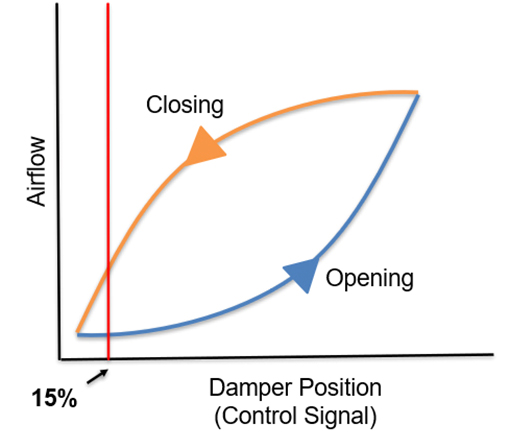Hysteresis in control dampers poses a significant challenge to achieving precise and repeatable airflow in HVAC systems. This phenomenon is a result of multiple mechanical and electrical imprecisions that, when combined, can result in significant position error. Therefore, relying solely on damper position or actuator feedback for airflow control is inadequate. These challenges can be mitigated by accurate, repeatable, and long-term stable airflow measurement devices regulating desired flow rates.
Example: Despite having the same control signal to the actuator, the damper ends up at different positions depending on direction of travel. This difference is caused by hysteresis, highlighting why relying solely on damper position is problematic. This phenomenon underscores the importance of precise airflow measurement solutions for consistent and reliable control.

Other documented impacts of Hysteresis in HVAC Systems
1. Challenges in Damper Modulation
According to the ASHRAE Fundamentals of HVAC Control Systems1 (Section 3.4), achieving precise damper modulation is inherently difficult due to friction in low-leak seals, linkage play, and aging components. This results in higher torque requirements and reduced responsiveness to small signal changes.
2. Impact on Minimum OA Control
ASHRAE transaction papers2,3 demonstrate both theoretically and experimentally that fixed damper positions fail to maintain consistent minimum outside air intake rates under variable flow conditions. They indicated that hysteresis exacerbates the inaccuracies of minimum OA control by fixed damper position, damper position reset strategies, and characterization of OA dampers, and that fixed damper position resulted in wasted fan energy.
3. Long-Term System Degradation
According to the ASHRAE Fundamentals of HVAC Control Systems1 (Section 7.4), friction, binding dampers, aging linkages, corrosion, and other factors will prevent the damper from responding to small changes in controller output pressure.
Repeatability2: A Critical Metric
Hysteresis impacts control repeatability, which is essential for maintaining system stability and performance.
Airflow Measurement: The Key to Overcoming Hysteresis
Ideal control strategies are those based upon direct measurement of OA rates4. Since hysteresis cannot be eliminated, accurate airflow measurement compensates for these limitations. By measuring actual ventilation rates, systems can dynamically adjust to maintain compliance with indoor air quality (IAQ) standards.
EBTRON’s thermal dispersion airflow measurement devices excel in this role by offering:
High accuracy: Across all airflow rates, especially low turndown applications.
Long-term stability: Minimizing recalibration needs through advanced technology.
Factory calibration: Traceable to NIST standards, ensuring dependable performance.
These devices mitigate the errors caused by hysteresis and ensure that HVAC systems deliver consistent, reliable airflow control.
Conclusion
Hysteresis fundamentally limits the repeatability of HVAC systems that rely on damper position alone. However, integrating accurate airflow measurement technologies, such as EBTRON’s solutions, bridges this gap. By doing so, systems achieve precise control, energy efficiency, and compliance with ASHRAE standards, ensuring both occupant comfort and operational reliability.
References
1. ASHRAE (2008). Fundamentals of HVAC Control Systems, Section 3.4, Section 7.4.
2. Drees, K.H., et al. (1992). Experimental Analysis of Measurement and Control Techniques of Outside Air Intake Rates in VAV Systems.
3. Janu, G., et al. (1995). Error Analysis of Measurement and Control Techniques of Outside Air Intake Rates in VAV Systems.
4. ASHRAE Research Project RP-980.

© 2023, EBTRON, Inc.
